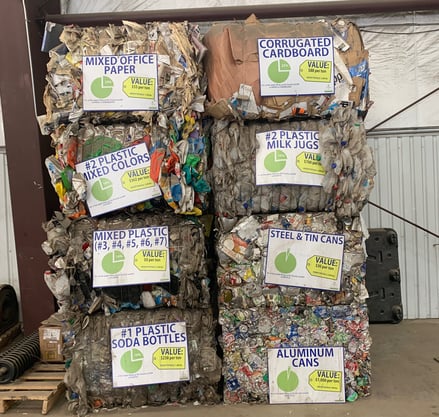What we can recycle, relies wholly on the manufacturers who are willing to buy and reuse them
After the expansion of US recycling programs in the 1970’s, recycling was something many people either actively practiced or were at least aware of. However, nearly half a century later, in 2019, the market that has kept recycling alive this long is a complete mystery to many. Like everything, recyclables have a market value based on supply, demand, and the current political climate. Each thing you recycle has an economic value which fluctuates depending on the prevailing need for that material, the environmental journalist Henry Grabar calls this process “The Transglobal Trash Trade”. This “trash trade” is the reason why recycling facilities accept or do not accept certain materials at different times, and why some recyclables are worth more than others.
 To better understand these differences in market value the Eagle County Materials Recovery Facility (MRF) put together a visual display of each type of recyclable they accept and how much one ton of each recyclable item is worth. For example, at the time they put this display together, mixed plastic (#3-#7) was worth $0/ton, while aluminum cans were worth $1,000/ton. One reason for this difference in value is aluminum cans can be recycled an infinite number of times in a true “closed loop” system, while plastics can typically only be recycled one to two times. Products like aluminum cans help make municipal recycling programs possible because the high value of aluminum helps compensate for the lower value of other items in the bin. Plastics, on the other hand, are cheap to make and aren't high quality when they're recycled. This leads to a very low demand for recycled plastics, which is why that ton of plastics #3-7 is worth nothing at all. While it's easy to think all materials that go in your recycling bin have value for reuse, that value depends wholly on the local (in this case US or North American) manufacturers who are willing to buy and reuse them.
To better understand these differences in market value the Eagle County Materials Recovery Facility (MRF) put together a visual display of each type of recyclable they accept and how much one ton of each recyclable item is worth. For example, at the time they put this display together, mixed plastic (#3-#7) was worth $0/ton, while aluminum cans were worth $1,000/ton. One reason for this difference in value is aluminum cans can be recycled an infinite number of times in a true “closed loop” system, while plastics can typically only be recycled one to two times. Products like aluminum cans help make municipal recycling programs possible because the high value of aluminum helps compensate for the lower value of other items in the bin. Plastics, on the other hand, are cheap to make and aren't high quality when they're recycled. This leads to a very low demand for recycled plastics, which is why that ton of plastics #3-7 is worth nothing at all. While it's easy to think all materials that go in your recycling bin have value for reuse, that value depends wholly on the local (in this case US or North American) manufacturers who are willing to buy and reuse them.
For the past 2 decades the US has shipped nearly 70% of our surplus of recyclables to China. Out of sight out of mind, right? Not quite. Our previous “easy way out” recycling system has come back to bite the US now that China shut its doors to most exported US trash and recyclables. When China started refusing our recyclables, the global demand for recycling plunged, relative to the supply, which made the cost of recycling surge. Mixed paper has dropped from $75/ton to $5/ton, with the surplus of supply. Additionally, it changed what many recycling facilities will accept, because they no longer had a buyer for their goods. China’s ban is forcing the US to face the fact that its current domestic recycling system is not robust enough to deal with the waste we're generating. Only 9% of plastic is recycled in the US, and with plastic use only increasing in recent years the US recycling system is going to have to improve, and quickly, in order to stay afloat. The US is already experiencing the difficulties that come with having to deal with our own waste, including a higher cost to recycle goods, fewer facilities to send recyclables to. All of which leads to increased confusion surrounding what can and can’t be recycled at a household level.
Since the US has recently hit multiple recycling barriers, it is time to look to other recycling systems and technologies for inspiration. Carbon taxes on landfills could create an economic incentive to recycle, charging companies for using plastics and putting the revenue back into recycling infrastructure, along with creating a national recycling system which local governments could opt into if they wanted, are all possible ways to improve the US’s current system.
Colorado is currently working to increase more domestic recycling-end-markets. The Colorado Department of Public Health and Environment, for example, has created a program called “NextCycle”. In 2018 NextCycle selected 9 teams based on their end-market recycling business ideas. One of the teams, Renewlogy, plans to convert plastic waste into fuel products and feedstocks. While another team, Ekomats, has proposed manufacturing multipurpose mats from #4 LDPE plastic film waste. These teams will submit their business ideas for the 2019 department grant cycle in hopes to implement their ideas in Colorado. The solutions are out there, and many inspiring changes are already being made. So, let’s continue reducing our waste, reusing when possible, and recycling what can be recycled through staying informed about the fluctuations in our local recycling markets.
SOURCES:
https://www.americandisposal.com/blog/a-brief-history-of-recycling
https://theweek.com/articles/819488/america-recycling-problem-heres-how-solve
https://slate.com/business/2019/04/recycling-dead-planet-profit-americans-commodities-china.html
https://www.wired.com/story/since-chinas-ban-recycling-in-the-us-has-gone-up-in-flames/
https://homeguides.sfgate.com/energy-recycle-glass-bottles-vs-aluminum-cans-vs-plastic-79276.html
https://www.aluminum.org/aluminum-can-advantage
https://slate.com/business/2019/04/recycling-dead-planet-profit-americans-commodities-china.html
https://resource-recycling.com/plastics/2018/08/01/epa-u-s-plastics-recycling-rate-declines/
https://www.wbur.org/earthwhile/2019/03/19/recycling-massachusetts-china-effect
https://www.buschsystems.com/resource-center/page/a-brief-timeline-of-the-history-of-recycling







